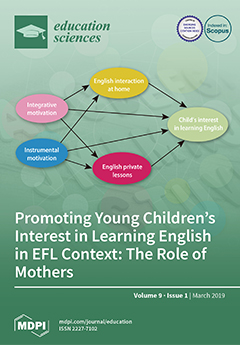An international consensus seems to have developed in educational research—and among educational planners and policymakers—during the last 10–15 years proclaiming that learning is, and must be, a visible phenomenon. This paper questions this predominant view and serves an assemblage of points offering educational
[...] Read more.
An international consensus seems to have developed in educational research—and among educational planners and policymakers—during the last 10–15 years proclaiming that learning is, and must be, a visible phenomenon. This paper questions this predominant view and serves an assemblage of points offering educational scientists at least four profound perspectives to reflect upon. First of all, learning is not immediately visible to the learning subject. It demands and deserves a qualitative lifelong perspective and—not to be underestimated—autonomous reflections to come to know and acknowledge what learning is and can be in an existential perspective. For the individual, it is always worth asking the question whether or not the things ‘learned’ in the first place were worth learning. Secondly, no one can examine the complex synaptic wiring process in the changeable and ‘learning’ brain (i.e., human neuroplasticity); the body-phenomenological depths and growth of a human being; or the manifold processes constituting the totality of historical social interactions surrounding the learning process and reduce them to something simple and already ‘known’ (a figure, a score, an effect, an answer in a test, an evaluation statement, etc). Thirdly, so-called visible learning for teachers has to be differentiated from both conscious and unconscious learning for pupils and students. The attempts to objectify and sometimes even instrumentalize learning risk running into obvious problems and fostering serious mistakes. Besides, the teacher and the ‘learner’ do not share the same perspectives and they often also have different interests. Fourthly, the concept of learning is not a value-neutral term and should only be used with an awareness of its historical development as a concept. I will argue that character formation—edification of character (
Bildung), in light of the rich German
geisteswissenschaftliche tradition—and the capability to think and become a vivid language user and creator demand much more than learning. Moreover, teaching is much more than a method to ‘produce’ learning, and to reproduce learning goals, and the purpose of education must transcend a teleological implementation of strategic national and international learning goals. In this paper, the revitalized concept of
Bildung both serves as a critique of the visible learning paradigm and as a take-off of an alternative and more fertile way to conceptualize the task and possibilities of education. The line of the argument and ambition of the paper is to depict how blindness seems to be an inevitable part of educational seeing. The thesis is that powerful scientific and political adherents of learning cannot see what they cannot see—neither when they see what they (think they) see, nor when they do not see what they do not (want to) see.
Full article





